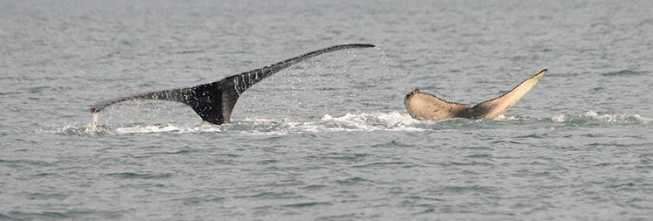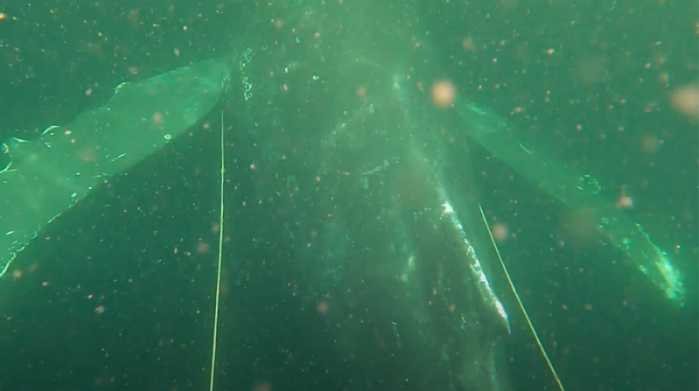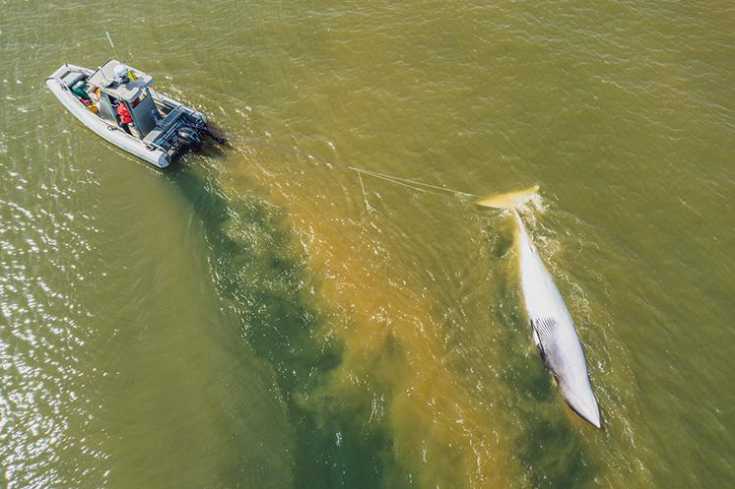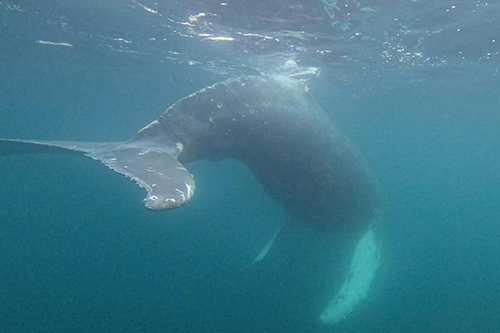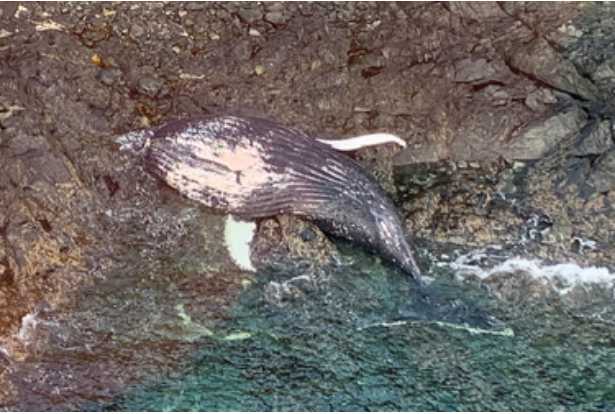NOAA and the U.S. Coast Guard worked together this 4th of July to free an entangled humpback whale in the Port of Valdez, Prince William Sound.
The NOAA Fisheries Alaska Marine Mammal Stranding Hotline received numerous reports late afternoon on July 3. A young humpback whale was entangled in the middle of the Port of Valdez, near Allison Point and the new harbor. The animal was believed to have multiple wraps of line around the base of its tail and was trailing a bright yellow buoy. A U.S. Coast Guard Station Valdez boat crew launched to get eyes on the situation to pass along observations to NOAA experts to determine the severity of the entanglement. The information and photos they collected from a safe distance, along with members of the public, were vital in enabling the NOAA entanglement experts and partners to create a rescue plan.
By the next morning, July 4, two NOAA large whale entanglement experts, Ed Lyman and John Moran, were en route to Valdez to lead an effort with the USCG to disentangle the humpback whale. Lyman is the regional large whale entanglement response coordinator at the NOAA Hawaiian Islands Humpback Whale National Marine Sanctuary. He works with NOAA Fisheries Alaska Region every summer to provide trainings and support for large whale entanglement response. He was instrumental in the recent successful disentanglement of a humpback whale near the Port of Dutch Harbor. Lyman had been in Alaska on assignment for several weeks, based out of Juneau. He was joined by a NOAA Fisheries’ humpback whale expert John Moran, based at the Ted Stevens Marine Research Institute in Juneau. Moran has conducted whale monitoring efforts in Prince William Sound for more than 18 years and knows the whales and the waters in the area. Both have a great deal of experience freeing whales from life-threatening entanglements.
Safely freeing 30- to 40-ton whales is always challenging. The remote location, the holiday weekend, poor water clarity, and weather posed additional challenges in this case. The response team needed help getting to Valdez and was able to get a ride across Prince William Sound from Cordova onboard USCG patrol boat Coast Guard Response Medium out of Coast Guard Station Valdez, crewed by Boatswain’s Mate Chief Edward Joshua Poole, Machinery Technician 1 Jacob Rubert, BM2 Shawn Casey, MK3 Owen Colby, BM2 Tyler Gugino, and MK2 Robert Fitch.
Working from the same boat and with the same crew, Moran and Lyman made several cuts with a hooked knife on a 28-foot-long pole. As the animal slowly moved into shallower water near the Valdez Marine Terminal, the team threw a cutting grapple (a grapple with blades on each of the tines) behind the animal. That’s what eventually freed the whale after 4 hours of effort, making for a long and different kind of celebration of freedom this July 4th for the team and the whale.
“The success of this mission was due to the support of the community, as they were the foundation of the effort,” said Moran.
“Coast Guard Station Valdez embarked on a 36-hour mission, with assistance from the NOAA team. This mission was accomplished thanks to the help from NOAA, successfully freeing the whale,” said BMC Edward Joshua Poole. “Any chance to work with NOAA, we always look forward to it.”
Untrained members of the public may be well-intentioned and trying to respond to an entangled whale. However, it is dangerous and illegal to respond without training and authorization from NOAA Fisheries. As a result, trying to free or otherwise assist a large whale, is best left to teams that are trained, well-equipped, and authorized to respond. These efforts are part of a national program overseen by NOAA Fisheries and their Marine Mammal Health and Stranding Response Program (and authorized under NOAA permit No. 24359). However, the community can—and in this case, did—play several important roles. They observed, provided initial assessment and documentation (from a safe and legal distance of at least 100 yards), and reported the entangled whale to NOAAʻs reporting Hotline (877-725-7773). They were able to fill the critical role of acting as first responders to a marine mammal emergency.
“Calling in these reports is extremely valuable as it allows us to respond when safe and appropriate, and also helps us gain information on various threats affecting the animals,” said Lyman. The best way for the public to help the animals is to report entangled whales to NOAA.
“We know it is tough seeing a whale entangled near your community, but their large size generally affords whales time because they are able to pull the gear to the surface, as was the case for this animal, for days to even months,” said Sadie Wright, Alaska Regional Large Whale Entanglement Response Coordinator. “This team, with community support, accomplished an amazing feat in getting to this whale quickly during a busy holiday, and safely and successfully freeing the animal.”
“This is one of the best operations I’ve seen in all of my travels to help disentangle whales. The U.S. Coast Guard was integral and the community provided information that enabled us to quickly and safely respond. Big mahalos!” said an enthused Lyman following the response.
Partners Key to Disentanglement Success
The success of this disentanglement is due to help from many groups including:
- Initial reports from community members and whale watch companies in Valdez
- Logistics assistance in Cordova (Chugach Regional Resources Commission)
- Logistics assistance in Prince William Sound (Stan Stevens Wildlife & Glacier Cruises)
- Transportation between Whittier and Anchorage (Premiere Alaska Cruises)
The U.S. Coast Guard Station Valdez and District 17 supported this response in several ways:
- Transportation between Cordova and the entangled whale
- Vessel support during the disentanglement effort
- Broadcast to Mariners notifying vessel operators of the response action
How to Assist An Entangled Whale
Entangled whales can be unpredictable and dangerous; maintain a legal and safe distance of at least 100 yards from all humpback whales. Exercise extra caution and distance from an entangled whale. Unauthorized responses, while well-intentioned, can result in additional injury and stress to entangled whales and increased safety risks to untrained responders. Please communicate with trained responders if you see an entangled whale.
- Call the Alaska Marine Mammal Stranding and Entanglement Network 24/7 hotline at (877) 925-7773
- Call the U.S. Coast Guard on VHF Channel 16
Information you provide may help trained, experienced, and well-equipped responders attempt to free the animal and at the same time gain information to reduce the threat of future entanglements.
If you’re interested in learning more about becoming a first responder, take the online training developed by NOAA Fisheries in partnership with The Nature Conservancy. It will guide you to more effectively document and communicate with NOAA to help free entangled whales. These reports are the best way to help the animal.
[content id=”79272″]

